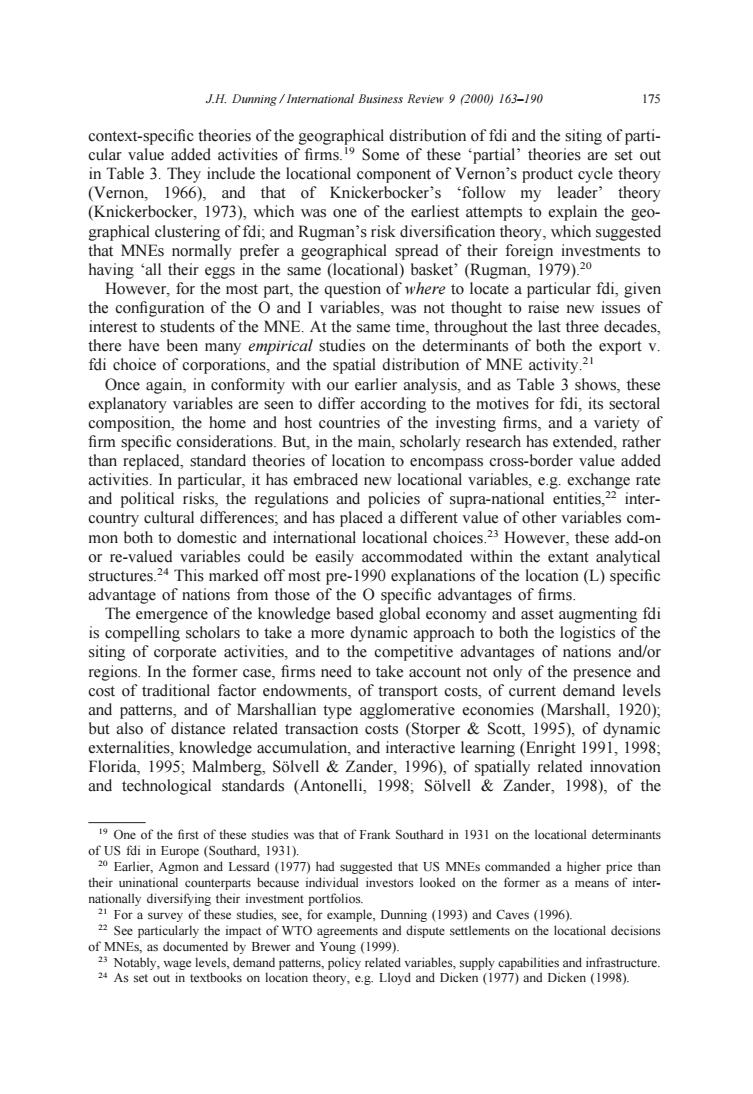正在加载图片...

JH.Dunning/International Business Review 9200)163-190 175 宽湿 dded ome of the partial non's proc follow ct cyer theory of my leade theory (Knickerbocker,1973),which was one of the carliest attempis to explain the geo- ha MMmt pelgcopicr o h m having 'all their eggs in the same (locational)basket'(Rugman,1979).20 However,for the most part,the question of where to locate a particular fdi,given the configuration of the O and I variables,was not thought to raise new issues of interest to students of the MNE.At the same time,throughout the last three decades, there have been many empirical studies on the determinants of both the export v. fdi choice of corporations,and the spatial distribution of MNE activity.?1 Once again in conformity with our earlier analysis.and as Table 3 shows.these explanatory variables are seen to differ according to the motives for fdi.its sectoral composition,the home and host countries of the investing frms and a variety of ss cross-border value added articular,it has embraced ne variables the of s other variables stic and I be easily n the extant analytica advantage of nations from those of the O specific advantages of firms. The emergence of the knowledge based global economy and d asset augmenting is compelling scholars to take a more dynamic approach to both the logistics of the siting of corporate activities,and to the competitive advantages of nations and/or regions.In the former case,firms need to take account not only of the presence and cost of traditional factor endowments,of transport costs,of current demand levels and patterns,and of Marshallian type agglomerative economies (Marshall,1920): but also of distance related transaction costs (Storper Scott,1995).of dynamic externalities.knowledge accumulation.and interactive learning(Enright 1991.1998: Florida.1995:Malmberg.Solvell Zander.1996).of spatially related innovation and technological standards (Antonelli,1998:Solvell&Zander.1998).of the ( was that of Frank Southard in 1931 on the onal det Earlier,Agmon and Lessard (1977)had suggested that US MNEs ommanded a higher price than as a means of inter their ause ina h f MNas documented by Brewer andyoug s and dispute settlements on the locational decisions and infrastructure an Dicken (1998) J.H. Dunning / International Business Review 9 (2000) 163–190 175 context-specific theories of the geographical distribution of fdi and the siting of particular value added activities of firms.19 Some of these ‘partial’ theories are set out in Table 3. They include the locational component of Vernon’s product cycle theory (Vernon, 1966), and that of Knickerbocker’s ‘follow my leader’ theory (Knickerbocker, 1973), which was one of the earliest attempts to explain the geographical clustering of fdi; and Rugman’s risk diversification theory, which suggested that MNEs normally prefer a geographical spread of their foreign investments to having ‘all their eggs in the same (locational) basket’ (Rugman, 1979).20 However, for the most part, the question of where to locate a particular fdi, given the configuration of the O and I variables, was not thought to raise new issues of interest to students of the MNE. At the same time, throughout the last three decades, there have been many empirical studies on the determinants of both the export v. fdi choice of corporations, and the spatial distribution of MNE activity.21 Once again, in conformity with our earlier analysis, and as Table 3 shows, these explanatory variables are seen to differ according to the motives for fdi, its sectoral composition, the home and host countries of the investing firms, and a variety of firm specific considerations. But, in the main, scholarly research has extended, rather than replaced, standard theories of location to encompass cross-border value added activities. In particular, it has embraced new locational variables, e.g. exchange rate and political risks, the regulations and policies of supra-national entities,22 intercountry cultural differences; and has placed a different value of other variables common both to domestic and international locational choices.23 However, these add-on or re-valued variables could be easily accommodated within the extant analytical structures.24 This marked off most pre-1990 explanations of the location (L) specific advantage of nations from those of the O specific advantages of firms. The emergence of the knowledge based global economy and asset augmenting fdi is compelling scholars to take a more dynamic approach to both the logistics of the siting of corporate activities, and to the competitive advantages of nations and/or regions. In the former case, firms need to take account not only of the presence and cost of traditional factor endowments, of transport costs, of current demand levels and patterns, and of Marshallian type agglomerative economies (Marshall, 1920); but also of distance related transaction costs (Storper & Scott, 1995), of dynamic externalities, knowledge accumulation, and interactive learning (Enright 1991, 1998; Florida, 1995; Malmberg, So¨lvell & Zander, 1996), of spatially related innovation and technological standards (Antonelli, 1998; So¨lvell & Zander, 1998), of the 19 One of the first of these studies was that of Frank Southard in 1931 on the locational determinants of US fdi in Europe (Southard, 1931). 20 Earlier, Agmon and Lessard (1977) had suggested that US MNEs commanded a higher price than their uninational counterparts because individual investors looked on the former as a means of internationally diversifying their investment portfolios. 21 For a survey of these studies, see, for example, Dunning (1993) and Caves (1996). 22 See particularly the impact of WTO agreements and dispute settlements on the locational decisions of MNEs, as documented by Brewer and Young (1999). 23 Notably, wage levels, demand patterns, policy related variables, supply capabilities and infrastructure. 24 As set out in textbooks on location theory, e.g. Lloyd and Dicken (1977) and Dicken (1998)